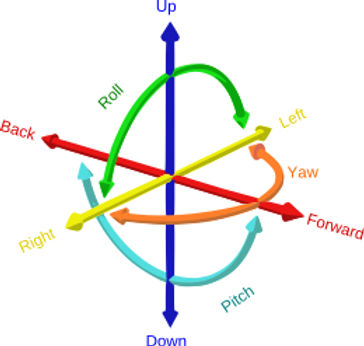Six Degrees of Freedom
6DoF
In the virtual world, there are several movement possibilities: 3DoF and 6DoF are the most common.

Definition
3DoF or Three Degrees of Freedom: the user can freely look around from a fixed position. Movement can be simulated with a VR controller.
6DoF or Six Degrees of Freedom: the user can freely look around and freely walk around.
What is Degrees of Freedom
Degrees of Freedom or simply DoF refer to the number of ways in which a rigid object can move through three-dimensional space. There are six total degrees of freedom that describe every possible movement of an object:
-
Three for rotational movement around the x, y, and z axes (also known as pitch, yaw, and roll).
-
Three for translational movement along those axes, which can be seen as forward or backward, left or right, and up or down.

VR headsets and input devices (e.g., hand controllers) are generally 3-DoF or 6-DoF. Degrees of freedom is a crucial concept in VR that allows human movement to be translated into movement within the VR environment. VR headsets thus come in two types: 3DoF and 6DoF
3DoF headsets
With 3-DoF headsets, we can only track rotational movements, but not whether the user has moved through the scene (translational movement) by physically moving. When a user wears a 3-DoF headset, we can only track whether that person:
-
Looks left or right
-
Turns their head up or down
-
Turns left or right
With 3-DoF, it is not determined whether the user has moved through the scene (translational movement) by physically moving. Particularly simple VR headsets use 3-DoF, such as smartphone headsets.
3-DoF headsets offer the simplest form of user registration in VR. It is mainly dependent on built-in sensors (accelerometers, gyroscopes, and magnetometers) that devices (such as smartphones) use to measure movement.
POSSIBLE APPLICATIONS //
-
Viewing 360-degree videos or images
-
Practicing giving a speech at school or a talk at a conference
-
Viewing a house for sale in VR before purchasing
6DoF headsets
With 6-DoF virtual reality headsets, we can track both translational and rotational movements.
We can determine whether a user has turned their head and moved:
-
Forward or backward
-
Laterally or vertically
-
Up or down
This type of tracking is important for VR experiences involving translational movement and gives the user much more freedom to explore locations, inspect details, and perform real-life tasks in VR.
Examples of 6-DoF VR headsets:
-
Oculus Rift
-
Oculus Quest
-
HTC Vive
-
Windows Mixed Reality
6DoF can be achieved in different ways. Early versions of 6-DoF headsets typically use positional tracking sensors (usually two physical devices placed in the room that can track the headset's movement) – for example, the Oculus Rift is embedded with infrared LEDs that are monitored by two 30 cm high sensor towers placed approximately 1.5 m apart.
POSSIBLE APPLICATIONS //
Modern VR headsets can use inside-out tracking to achieve 6-DoF. From the Microsoft Mixed Reality documentation: "The tracking system uses two visible-light cameras with low resolution to observe features in your environment and combines this information with IMU data to determine an accurate position of the device in your environment."
Action games where the user must avoid objects (e.g., bullets).
-
A car mechanic inspecting a vehicle's engine.
-
A cooking simulator teaching the user how to prepare a meal.